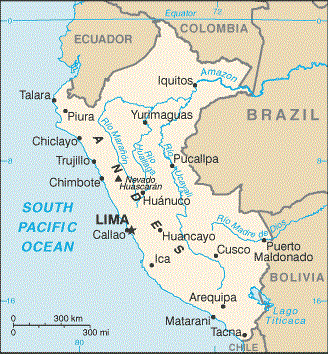Peru
.jpg)
The spectacular 22,205-foot (6,768-meter) Huascaran Norte in the Cordillera Blanca. (Photo by Gabe Colburn, C4C)
Many powerful civilizations once called ancient Peru their home. One of the more prominent peoples in history to occupy this land were the Incas. However, in spite of thier stature, upon the arrival of the Spanish conquistadors in 1533, the Incas saw their empire captured and virtually destroyed. After almost 300 years of foreign occupation, Peruvian independence was declared in 1821 and fully realized in 1824. Since then, Peru has faced many years of corrupt and selfish government officials, dictators, and military rulers that have made economic and social growth difficult. Nevertheless, after President Alberto Fujimori was elected in 1990, there were many positive economic changes. He also made significant progress in decreasing the large extent of guerilla activity.
However, President Alberto Fujimori relied heavily on strict and controlling measures which, coupled with a season of economic struggle led to his being ousted in the year 2000. A temporary government managed a new election in the spring of 2001, when the nation’s first president of native ethnicity was elected. In the next election in 2006, Alan Garcia Perez returned to the presidency. He previously served as Peru’s head of state from 1985 to 1990. Since his election in 2006, many of the mainstays of Peru’s economy, such as fishing, mining, agriculture and tourism have seen strong growth. According to the CIA World Factbook, in spite of these positive changes 35 percent of the population lives below the poverty line.
.jpg)
Rural girls — or Niños campesinos — in Pashpa town, Huraz, Peru. (Photo by Edwin Milla, C4C Peru)
Although religious freedom is guaranteed in Peru’s constitution, the Catholic Church (recognized officially as the state church), is said to receive some preferential treatment. For example, may non-Catholics have faced discrimination in taxes, property, education and politics. However, the Catholic Church is losing many of its members to evangelicals, foreign sects, atheism, and even revived Andean Paganism. There are many other spiritual challenges presently facing the people of Peru; for instance, a lack of unity among the followers of Christ, the rise of atheism and ethno-religions, as well as drug fabrication and trafficking to name a few.
Fast Facts
Location: Western South America. Leader: President Alan Garcia Perez (since July 2006) Population: 29,250,000 Primary Religions: Roman Catholic 81 percent, Evangelical 13 percent, most others are classified as ethno-religions or no religion.
Where in the World?

Peru (shaded above) is located in Western South America, bordering the South Pacific Ocean, between, Bolivia, Brazil, Chile, Colombia and Ecuador.
7578